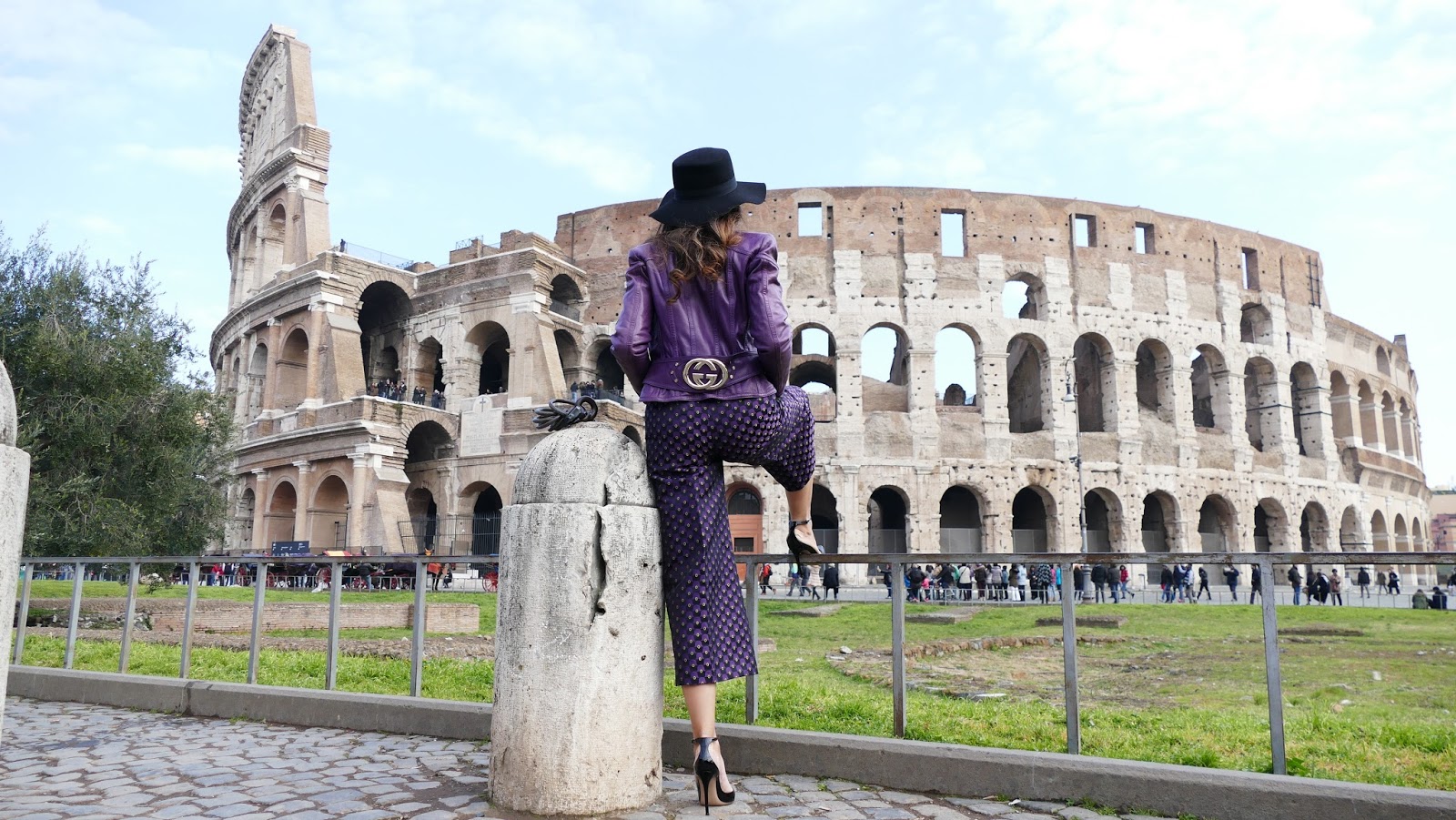
La costruzione del più grande anfiteatro dell’ Impero Romano fu iniziata da Vespasiano nel 72 d.C.: un dono al popolo per offrire gratuitamente divertimento e distrazione.
Un edificio di forma ellittica, sostenuto da una piattaforma in travertino, dalla quale si innalzano numerose volte, lungo 189 metri e largo 156, su una superficie di 24.000 mq e un’altezza di più di 48 metri.
Originariamente conosciuto come Anfiteatro Flavio, o semplicemente Amphiteatrum, fu inaugurato nell’anno 80 da suo figlio Tito.
In grado di ospitare fino a 50 mila spettatori, era usato come luogo di scontro tra gladiatori e messe in scena di drammi mitologici e rappresentazioni di caccia con animali esotici e feroci.
Gli spettacoli divennero occasioni per meravigliare e scatenare l’entusiasmo del popolo attraverso un dispiego senza precedenti di effetti speciali.
Il nome è sicuramente legato alle grandi dimensioni dell’edificio ma deriva, soprattutto, dal fatto che nelle vicinanze era presente una statua colossale di Nerone in bronzo.
Nel 1990, il Colosse è stato inserito nella lista dei Patrimoni dell’umanità
dall’UNESCO, mentre nel luglio del 2007 è stato inserito fra le Nuove Sette Meraviglie del Mondo.
dall’UNESCO, mentre nel luglio del 2007 è stato inserito fra le Nuove Sette Meraviglie del Mondo.
Tuttavia, non credo sia necessario essere appassionati d’arte o di storia
per apprezzare l’Amphitheatrum Flavium. Non è necessario riconoscere i vari
stili delle colonne, l’architettura delle arcate, i materiali usati per
costruirlo. Non è necessario nemmeno essere esperti dei giochi e delle
cacce fatte nell’arena o delle armi dei gladiatori. L’imponenza del monumentale capolavoro architettonico va
al di là di ogni studio e specializzazione.
per apprezzare l’Amphitheatrum Flavium. Non è necessario riconoscere i vari
stili delle colonne, l’architettura delle arcate, i materiali usati per
costruirlo. Non è necessario nemmeno essere esperti dei giochi e delle
cacce fatte nell’arena o delle armi dei gladiatori. L’imponenza del monumentale capolavoro architettonico va
al di là di ogni studio e specializzazione.
Indosso un outfit nelle sfumature del viola, uno dei colori più glamour per questo inverno 2017, mentre mi soffermo incantata ad ammirare il nobile recinto dove si manifesta tutta la storia dell’Antica Roma.
(Clicca qui se ti sei perso i miei precedenti post da Roma).
Located just east of the Roman Forum, the massive stone amphitheater
known as the Colosseum was commissioned around A.D. 70-72 by Emperor
Vespasian of the Flavian dynasty as a gift to the Roman people, able to accommodate up to 50,000 spectators. In A.D.
80, Vespasian’s son Titus opened the Colosseum, officially known as the
Flavian Amphitheater, with 100 days of games, including gladiatorial
combats and wild animal fights.
known as the Colosseum was commissioned around A.D. 70-72 by Emperor
Vespasian of the Flavian dynasty as a gift to the Roman people, able to accommodate up to 50,000 spectators. In A.D.
80, Vespasian’s son Titus opened the Colosseum, officially known as the
Flavian Amphitheater, with 100 days of games, including gladiatorial
combats and wild animal fights.
The shows became occasions to amaze and unleash the enthusiasm of the people through an unprecedented deployment of special effects.
The Flavian Amphitheater is elliptical in shape, with a circumference
of 527 meters, 188 meters along the major axis and the minor axis 156 meters high.
The name is undoubtedly linked to the large size of the building but
derives above all from the fact that nearby there was a colossal bronze statue
of Nero.
In 1990, the magnificent architecture was listed as a UNESCO World Heritage, while in
July 2007 it was included among the New Seven Wonders of the World.However, I do not think is necessary to be art lovers or history to appreciate the Amphitheatrum Flavium. You
do not need to recognize the different styles of the columns, the
architecture of the arcades, the materials used to build it. It is not even necessary to be an expert of games and hunts made in the arena by the gladiators. The grandeur of the monumental architectural masterpiece goes beyond any study and specialization.
I’m wearing a purple outfit, one of the most glamorous colors
for this winter 2017, while I’m fascinated by the noble
enclosure where is manifested all the history of ancient Rome.
of 527 meters, 188 meters along the major axis and the minor axis 156 meters high.
The name is undoubtedly linked to the large size of the building but
derives above all from the fact that nearby there was a colossal bronze statue
of Nero.
In 1990, the magnificent architecture was listed as a UNESCO World Heritage, while in
July 2007 it was included among the New Seven Wonders of the World.However, I do not think is necessary to be art lovers or history to appreciate the Amphitheatrum Flavium. You
do not need to recognize the different styles of the columns, the
architecture of the arcades, the materials used to build it. It is not even necessary to be an expert of games and hunts made in the arena by the gladiators. The grandeur of the monumental architectural masterpiece goes beyond any study and specialization.
I’m wearing a purple outfit, one of the most glamorous colors
for this winter 2017, while I’m fascinated by the noble
enclosure where is manifested all the history of ancient Rome.
(Click here to read more about all the shades of purple, one of the trendiest color of the season).
(Click here to see all my previous posts from Rome).
Location: Roman Colosseum – Rome – Italy 

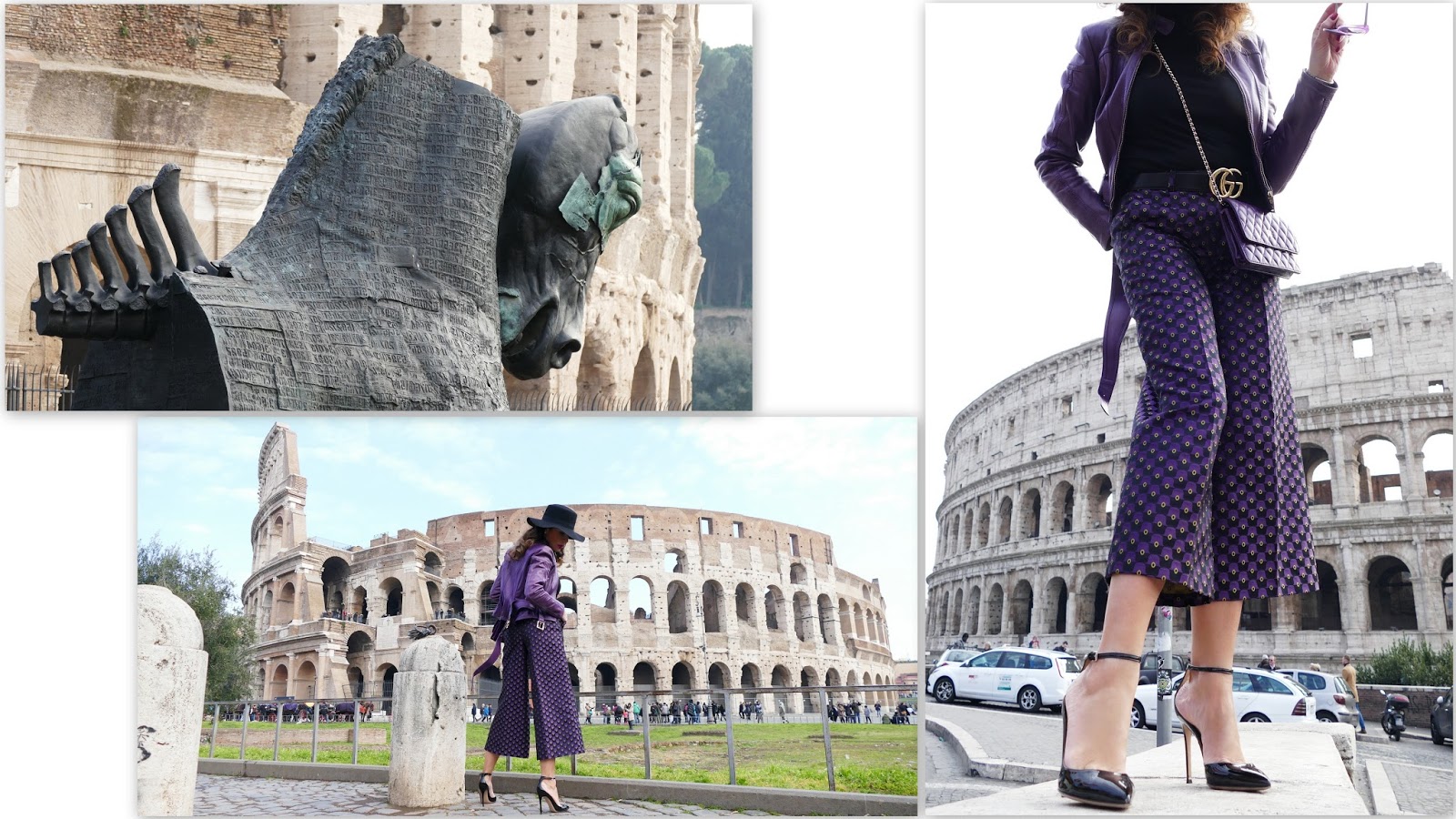

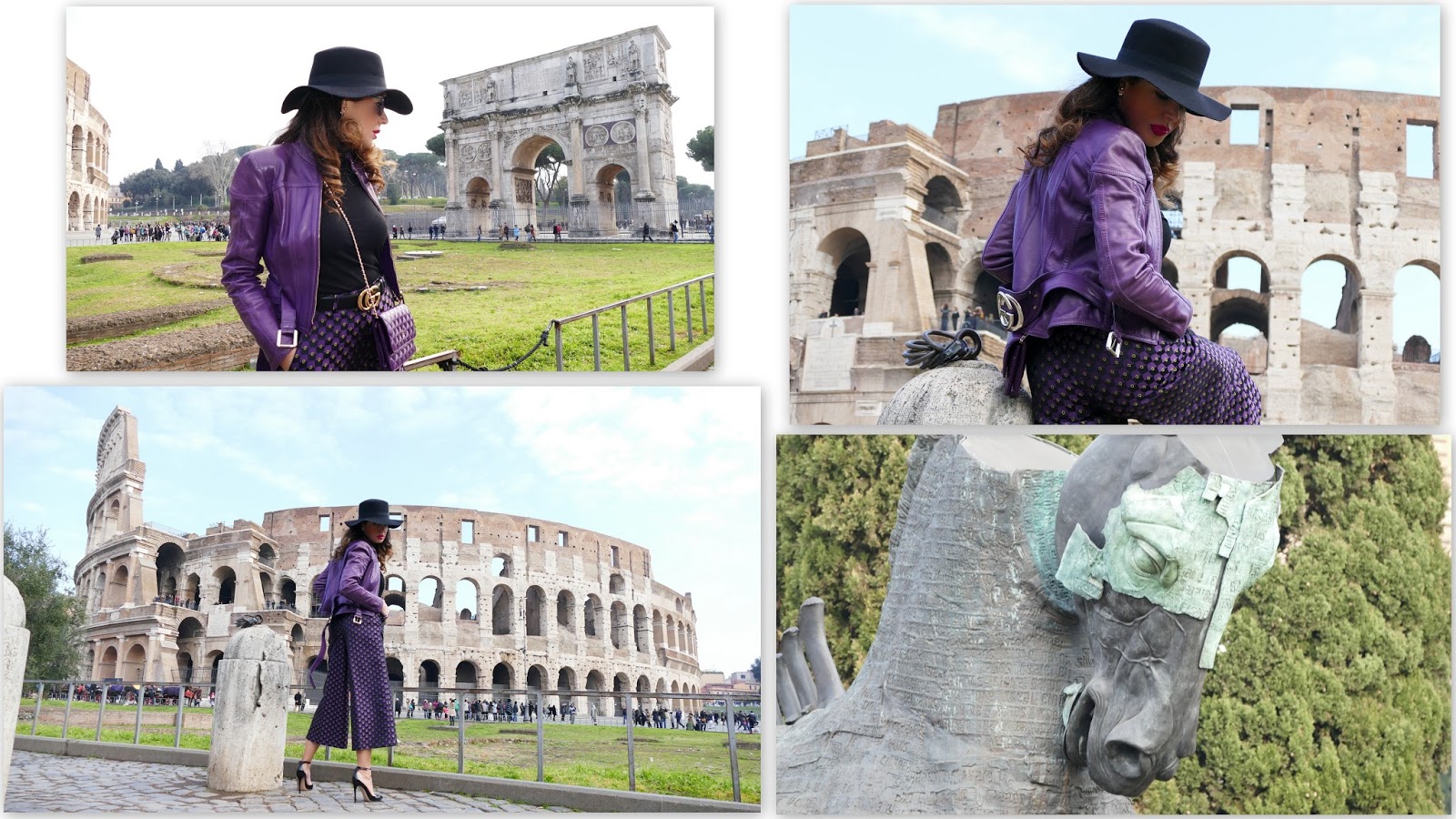
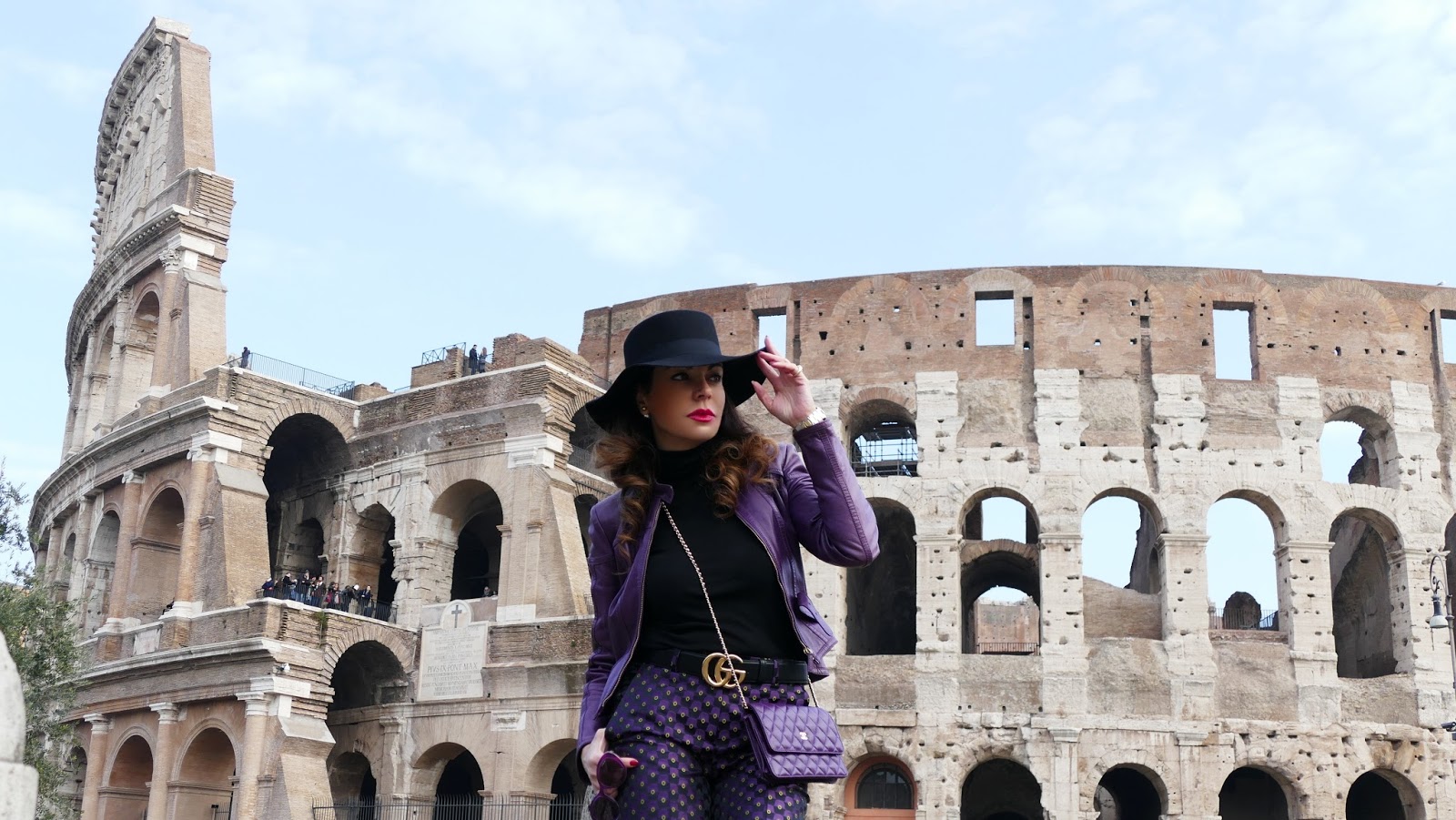
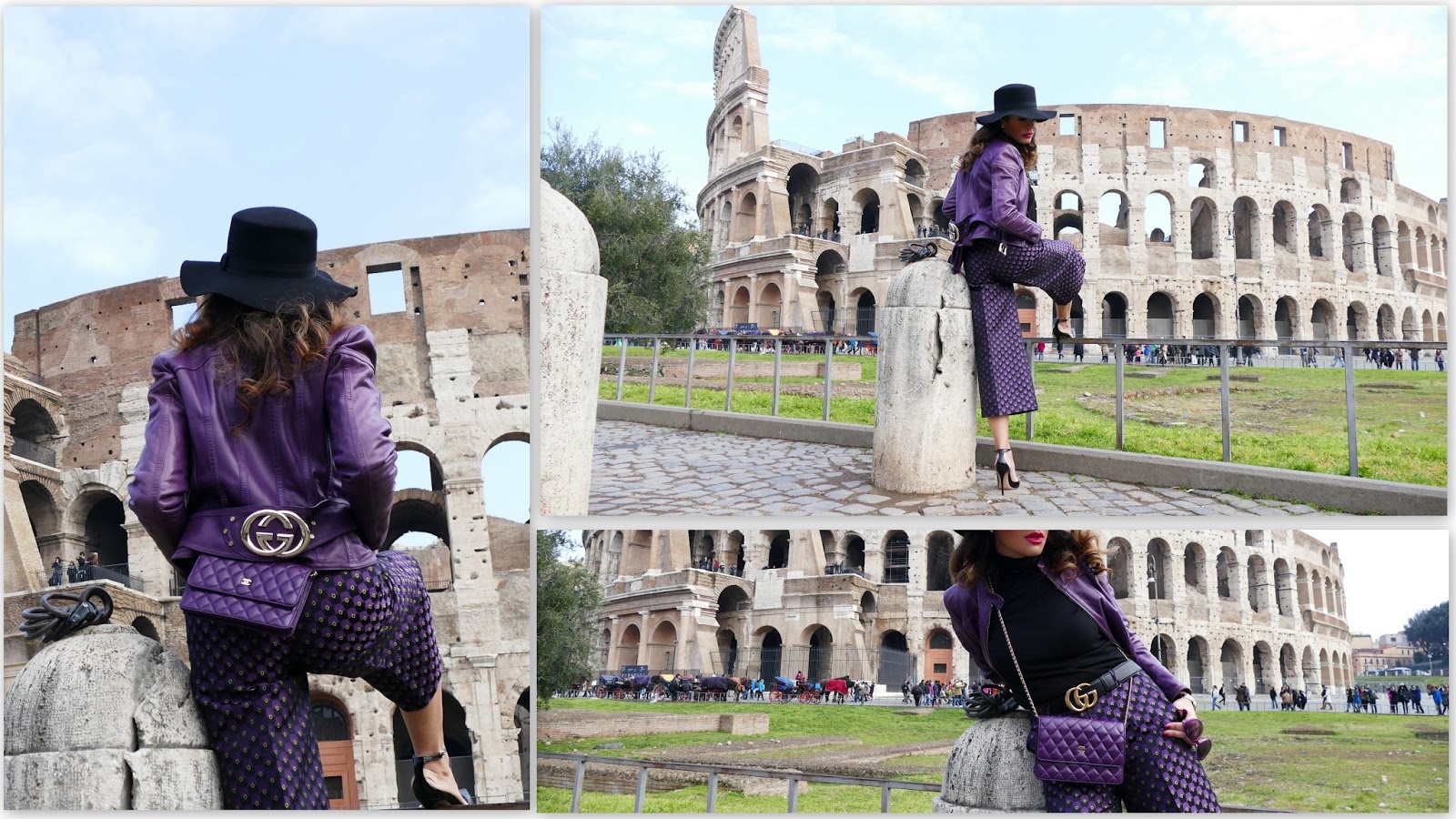


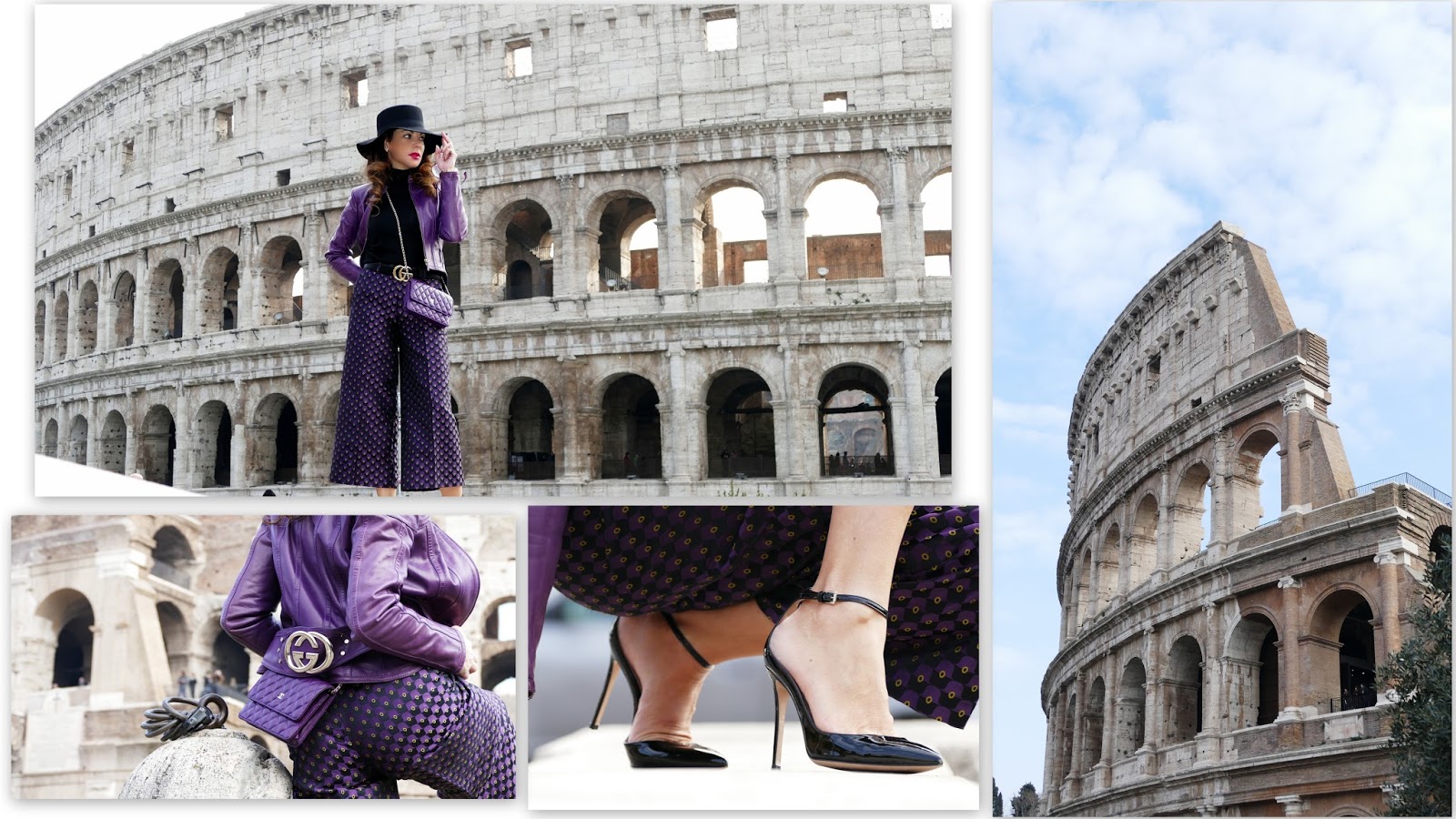
Photos: GerardoFusco.it
I was wearing:
Gucci leather jacket
Patrizia Pepe turtleneck
One culotte pants
Gucci belt
Vogue sunglasses
Chanel bag
Gianvito Rossi heels


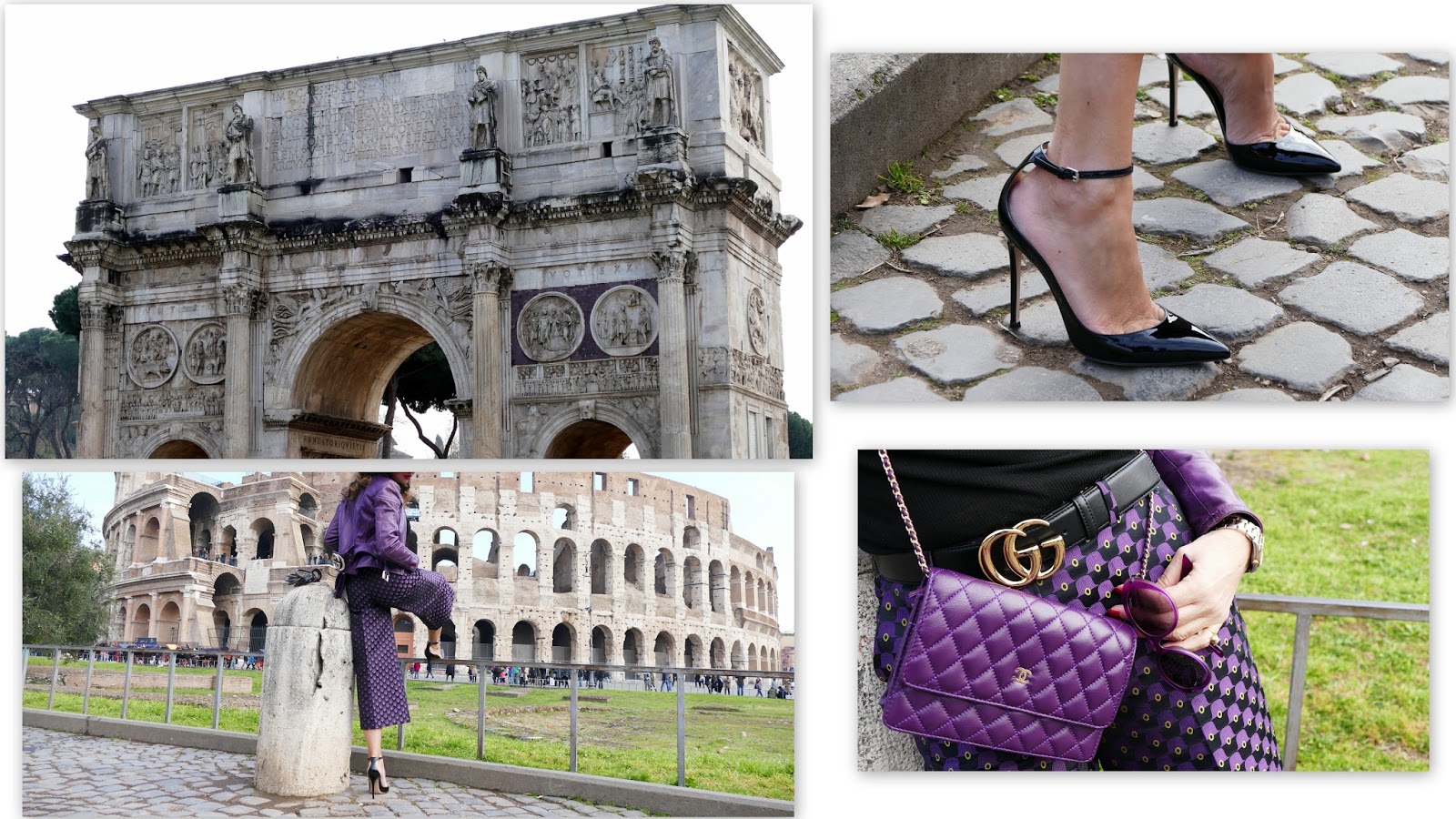

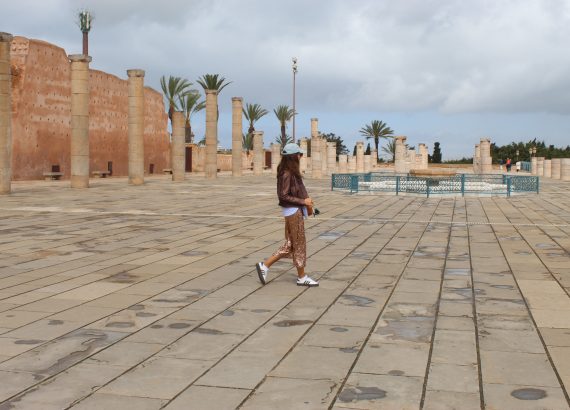
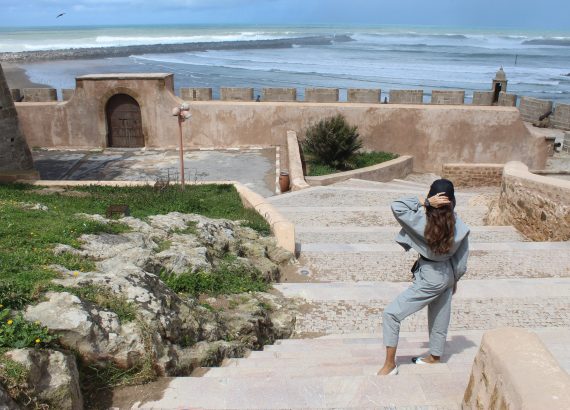
What a marvelous sight to behold! Thanks for the photos and the history lesson Paola!
Stunning pictures Paola. Purple is definitely your color.
Simera |Beautetude
Purple is definitely your colour! This outfit is amazing.
the-creationofbeauty.blogspot.com
I love the purple and black combination so chic.. The heel height of those shoes are giving me serious life
Glowyshoes's blog
Favolosa la giacca in pelle di Gucci. Kiss
“Elisabetta Franchi La mia Bambina, in passerella durante la MFW” ora su http://www.littlefairyfashion.com
Il viola non è uno dei miei colori preferiti, ma su questo look non posso dire nulla, se nn che sei favolosa e il look è top fin nei minimi dettagli… poi la location è la più bella del mondo! Baci
The purple bag and jacket is stunning ! Wow ! Great photos like always.
http://www.pink-purpledots.blogspot.com
Meravigliosa in viola, adoro la stampa dei pants!
Bacioni
Martina
http://www.pinkbubbles.it
Roma è Roma! Un splendida location per i tuoi scatti!
LA BORSA DI MARTINA
Thanks a lot 😀
you look awesome 😀 In love with your coat
NEW BRANDING POST | EVENT: Ecco Shoes Openning Day .
Instagram ∫ Facebook Oficial Page ∫ Miguel Gouveia / Blog Pieces Of Me 😀
Colosseum is really impresive.Your purple styling is stunning!!!! I love your culotte pants 🙂
What beautiful pictures Paola, love the purple!
Have a great day 🙂
Rosanna x
Rose's Rooftop
Uno spettacolo d'architettura, vorrei tornare presto a Roma per visitarlo. Sei bellissima Paola, le sfumature viola ti donano molto. Un bacio!:*
Damn, Paola love your outfit!!!
Bernie, xx
The Style Fanatic
Really stylish look) Thanks for sharing)
http://beyoutiful.com.ua
Love all the purple, fantastic. Have a wonderful day x
Wow this has got to be one of my favourites. I love the purple colour with the black. It's perfect.
Gemma x
http://www.jacquardflower.uk
Wow, great style dear! 🙂
Kiss
New post on my blog: http://vesnamar.blogspot.rs/2017/03/yellow-green-outfit.html
mi sono soffermata 10 minuti a leggere con calma i dettagli storici del post di oggi che come al solito mi affascinano, amo l'arte
Mi piace il total look viola
Kisses darling
Bellezza pour femme – fashion blog di Marzia Amaranto
this looks awesome 🙂 thanks for sharing!
http://www.pinkoolaid.com/
Oddio Paola, sempre più bellaaa!! Quetso look è strepitoso, un punto di viola pazzesco e le foto si commentano da sole! TOPPPP!!!
Un bacione! 💕 F.
La Civetta Stilosa
Gorgeous look!
Kisses
❤❤❤❤❤❤❤❤❤❤
Meu cantinho Lusitana❤Blog
“Página- FACEBOOK”
Novo post: “ WISHLIST BANGOOD”
Me encanta tu look de hoy belleza!!!! feliz día! un besazo! te espero en blog
http://www.ShoesAndBasics.com
The jacket its to die for love it.
Che devo dire? Se non che i tuoi Look mi piacciono sempre moltissimo!!!!!!
http://www.glitterchampagne.com
So beautiful pics and place, I love Rome! About your outfit, is just perfect, purple looks great on you!
Kisses,
http://www.theartofpaloma.com/
Amei o post.
Blog SOS Pedro
So nice!
** Join Love, Beauty Bloggers on facebook. A place for beauty and fashion bloggers from all over the world to promote their latest posts!
BEAUTYEDITER.COM
Bellissima combinazione in nuance viola, la giacca è un vero amore
http://www.treschic.fashion
@mariajosegomezverdu
La classe è innata …… tu ne hai da vendere . Number 1
Baci Cherie
http://unconventionalsecrets.blogspot.it
Purple is one of my favorite colors… I really adore the leather jacket… it looks fabulous on you Paola xox ♡
Love the colour combination! Have a great week, dear! xoxo
look super!!!!
http://www.befashion31.com/
Grazie Mary!
xoxo
semopre super TOP!
baci Gina
new post
F-Lover Fashion Blog by Gina Beltrami
ma che stupendi questi pantaloni…bellissimo questo look monochrome!
sei sempre bellissima!!!!
http://modaodaradosti.blogspot.ba/
quanto mi piace questo colore 🙂
http://www.carmy1978.com
I love this purple color on you! The Coliseum is so beautiful!
http://violettedaily.com
That Outfit is stunnig.I love how you combined everything together and the colour is perfect:)
http://aliceimkleiderschrank.blogspot.de/
molto bello questo outfit sono davvero particolari i pantaloni
un bacione
admaiorasemper.website
Wow! What a spectacular setting and an amazing outfit. I love the contrast between antiquities and such a cool, modern outfit. You have amazing style – I just love the stiletto ankle-strap pumps with your culotte pants. And the color is so rich and gorgeous – contrasts beautifully with your hair!
xo, janea
http://www.theSTYLEtti.com
Great post, amazing photos and i love your sense of style so powerful.
Best
Beautiful architecture. Your style your fabulous. You look stunning in purple.
Xx
Nikki
http://www.nikkilivinglife.com
Questo sicuramente non è un colore facile e alla portata di tutti..ma tu sei incantevole e lo indossi con una disinvoltura da fare invidia!
50 mila spettatori, wow, incredibile! Il popolo voglia pane e circus… Mi piace questo luogo moltissimo, ho alcune fotos, ma non cosi bella ed elegante come te! Mi piace vila moltissimo, le culottes, le scarpe sono bellissime ed il cappello, borsa, Gucci belt! Sei davvero sempre bellissima, oggi ancora piu! Baci, una bellissima giornata per te!
DenisesPlanet.com
Oh my, I love that outfit! Purple is my all time favorite color! <3
TheNormcoreRebel
Bellissima anche viola, non sbagli un colpo!!!!
Baciiiiiiiii
Marta
http://www.lagattarosablog.it
Che bello questo look tutto viola un bacione
http://denimakeup95.blogspot.it
Adoro questo colore!!! Sei perfetta Paola! E gli accessori sono strepitosi! Un bacione Bellezza!
♥☻♥☻♥
Jeanne
http://fashionmusingsdiary.com
Che splendido look Paola. Il viola è veramente elegante e su di te ancora di più.
un bacione
Maggie Dallospedale
Indiansavage.com
I dream to go to the circus!! it's amazing
kisses beauty
http://www.aprendiendoaquererme.com